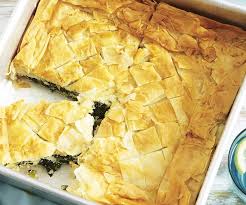Filo pastry and how foods travel
- rosemarydearman1
- Jan 11, 2020
- 6 min read
"The origin of the current practice of stretching raw dough into paper-thin sheets is highly debated, unclear and unknown." Wikipedia

Yesterday I bought some filo pastry. I had a big bunch of spinach and I was undecided about what to do with it, and so I thought to buy some filo pastry to keep my options open. And there's a thing that shows that times have changed - why would I think of filo when I think of spinach? It's pretty easy to get filo pastry - well Aldi seem to have stopped stocking it, and I can never find it in Woolworths, though I know it's there somewhere. Anyway I bought mine in Coles. I always buy mine fresh but you can get it frozen. Not as good I believe - it can stick together.
The point is that when I was a child I had never heard of filo. Now it is commonplace. So I reflected a little on how this had come to be as I walked back from the shops, and decided that the reasons were different for here in Australia and back there in England. Here in Australia it's pretty obvious why. We had lots and lots of Greek immigrants back in the 50s. At one point Melbourne was the second largest Greek city in the world after Athens, so it's not surprising that they brought their foods with them. When we first arrived in Australia the whole of Victoria Street at the edge of the city was Greek. As the Greeks prospered and moved out to the suburbs the street changed to being Vietnamese, which it remains to this day.
The Greeks set up cafés and cake shops and we gradually came to love their food, particularly the sweet baklavas and other pastries and the savoury spanakopita, which is now one of Melbourne's favourite fast foods. After a while we decided we would like to make these things at home and so various enterprising Greeks set up filo factories - and that's how we get it at the supermarket. Well I don't know whether there were several people doing this or just one family - the dominant supplier now.
So a slight digression here to tell you about the company called Antoniou which is the primary producer of filo pastry here in Australia. It is, of course, another immigrant success story.
Chris and Marina Antoniou came to Sydney from Cyprus in 1952. They set up a tailoring business in Sydney which was pretty successful. However, Chris, like many immigrants had actually been doing two jobs and the second was in a Greek cake shop, where he learnt to make filo pastry. Now isn't that sort of ironic? Anyway when the chance came to supply Sydney's two - yes just two - Greek cake shops - with filo, in 1960, the couple decided to make filo in a small building next to their tailoring business. Can you imagine how hard this family worked? It apparently took twelve hours to make the pastry - so who was doing the tailoring and when? For I'm sure that the children would also have been involved - and of course they now run the business. The filo was made by hand and in the video here you can see the man himself showing how to stretch it, in an interview with Tess Mallos - whose book I use for my baklava recipe. The video is rather quaintly dated but has quite a few useful tips about using filo.
Like all skilful things - bricklaying springs to mind - he makes it look incredibly easy to stretch it. Mind you Felicity Cloake who had a go at making filo pastry by hand said that it was actually pretty easy, and I did see one recipe that said your only enemy was fear. I think you have to get the dough right probably. King Arthur Flour have a pretty detailed recipe for making it by hand so you could give it a go some time. Is it worth it? Well back to Felicity Cloake who was making strudel:
"Time to roll it up and get it into the oven, alongside a strudel made from exactly the same filling, but with the bought filo. Even an amateur like me can tell the difference immediately: the homemade strudel pastry is soft and elastic while the filo is brittle and papery. Although both are brushed liberally with melted butter before they go into the oven, the Leiths version emerges with a far richer flavour. Its inner layers are deliciously gooey with apple juice, in contrast to the obstinately plain filo; in fact, at the risk of boasting, there really is no contest. I put the rest of the roll in the freezer for baklava."
Packaged filo on the left, hand-made on the right. And I have to say that in that video Chris Antoniou showed how to recognise good bought filo - crumple a sheet up and then shake it out. If it's good it will just shake out to its original shape. If it's not it will break and crumple.
To finish the Antoniou story. It wasn't until 1969 that the family decided to focus solely on making filo pastry - such was the demand for their product. All of the time until then they had actually been operating two very different businesses. When did they sleep one wonders? So Chris went to America to buy a filo making machine and imported Australia's first which was set up in a small factory in St. Peter's.

The factory has now moved to Moorebank and is, of course much larger, with their products being sold throughout Australia and also overseas. Chris is now dead, but Marina is still there with the business being run by their son, sons-in-law and grandchildren. Yet another example of a successful Australian company created by extremely hard-working, dedicated and ambitious immigrants.
This, I'm afraid, is turning into a true Rosemary ramble. Where was I?
Back to England where there were probably some Greek immigrants, but not as many as here. However, post war, the British - the ordinary British, not just the rich were beginning to holiday in Europe thanks to package tours and decreasing travel costs. As a child and young teenager I remember sending off for all the package tour brochures, and dreaming of places we could go. We never did. I suspect that our family could not afford it. So I did my French exchange holidays instead - which were, of course, wonderful.
Greece would have been a favourite destination for the travelling hordes though - maybe only second to Spain. And truth to tell, I'm a little surprised that I have never been there. The nearest I got was to Yugoslavia. The point is though that when we travel, unless we are one of those dreadful tourists who demand their own food in a foreign country, we eat the food of the country and discover wonderful new flavours. So when we get back home we try and reproduce what we have eaten. It reminds us of good times as well as being delicious and different. And because lots of people went to Greece, then lots of people started searching for baklava and spanakopita and ultimately wanted to make their own. Our own trips to Yugoslavia induced in us a love of sausage stew made with capsicum and tomatoes - it was virtually all the food that we could buy to cook up in our campsite. But when we got home we had to search for that particular kind of sausage. In fact I don't know that we ever found any in England, but capsicums were becoming available, but fortunately soon after we came to Australia, where the Yugoslav immigrants must have been busy making sausages. You could certainly buy kabana sausage when we arrived here in 1969, and that was like the sausages we had eaten in Yugoslavia,
Historically, even though the origins are unclear - some say Ancient Greece, some say Byzantium, some say Turkey, it is certainly true that the Turks took it to Hungary and Austria where it turned into strudel pastry. And maybe, when I think about it, this is how we first knew of filo in England. In fact they probably eat more strudel than spanakopita there. Although maybe not.
Filo pastry is so versatile. These days all the best chefs will be doing something with it. Here are some pictures of some of those things. It's sort of sculptural really. You just have to remember to slather it with butter or oil, although Tess Mallos, in that video seemed to think you only needed a dab here and a dab there. Not sure about that and I don't think Chris Antoniou was either.
Does the rest of the world do paper thin pastry? Well the Asians have won ton wrappers and spring rolls which are certainly thin, but not the same and not used in the same way really. And not quite as thin either. The Middle-Eastern and North African countries use filo - but their versions probably come from the same source as the Greek filo. Don't know about the rest of Africa, or Central and Southern America.
And after all of that I have decided to go with gnocchi instead. But I'll do something with mushrooms and ham tomorrow in filo pastry, I think - perhaps in a spiral kind of thing.






























Comments